Photographer Q&A: Justin Van Leeuwen’s “Extreme Families” photo sessions offer a wild take on group portraits
posted Tuesday, November 20, 2012 at 2:33 PM EDT
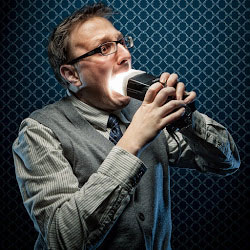
Ottawa, Canada-based photographer Justin Van Leeuwen (right) has found success with a unique type of group photography he calls Extreme Families photo sessions. The technique involves compositing family members together into unique scenarios designed to reflect their true personalities and identities. As you can see from some of his photos on this page, these "extreme" family scenarios can be whimsical, outrageous, scary, or just plain hilarious.
A father to three children himself, Van Leeuwen says Extreme Families is not for everyone. However, some of his clients love it. We caught up with him recently and asked him a few questions about his family portrait techniques.
IR: How did you come up with the idea for the Extreme Families photo sessions?
Van Leeuwen: The idea behind the Extreme Family photo series was a result of me doing my own self-portraits with my sons. I had started a "Stay at Home Dad" series because, while I was supposed to be a photographer-dad, raising two boys during the day was the full-time job. I still wanted to create, and I was really curious on expanding my Photoshop abilities, since I have an interest in more commercial photography. After I received good feedback for those, I was approached by some people I knew to do something similar with their families. It was appealing to them (and me) because we're able to create the photograph in stages.
IR: Explain how you create these unique group photos.
Van Leeuwen: By compositing multiple shots together, I can work with one kid or family member, at a time. Often for my own images I'd do setup and shoot one of my sons while the other was napping. It became a very fluid and calm way of working. In a conventional family portrait there's always a compromise between who looks best in which shot, and there's a chance one family member just doesn't look as good as they want. With these photos we get to pick our favorite images and put them all together, making everyone happy in the end! As for "extreme," that's a phrase my friend Angela came up with to describe my own family. I've found my clients are a little more conservative than I am, which is why they don't actually seem very extreme, but the name prevailed since "Composite family photography" doesn't sound as cool.
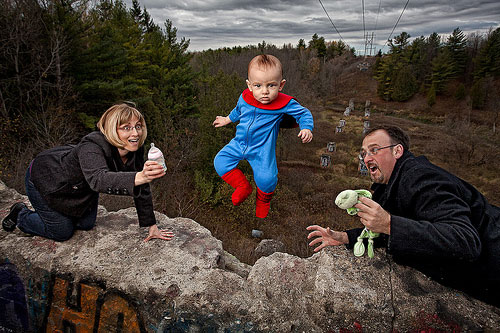
IR: You've described the process for Extreme Families as collaborative. Tell us about how work with a family to come up with the right scenario.
Van Leeuwen: I start by asking my contact at the family (most often the mother, dads are either along for the ride, or questioning why they have to pay so much for one photo) about their family, individual character traits, interests, locations that are meaningful or relevant to the family. I then sort of process all that information in my own warped head and spew out a few different scenarios. These are often a bit crazier than my clients are willing to display, but it's easy to tone it back and alter a bit until it fits. I think, for me, being able to have a good understanding of how people interact with each other helps me build a scenario in my imagination that ends up being pretty close to home. In a few cases the family already knew what they wanted: "We play hide-and-seek with our son every night before bed. That's what we want." Cool, it's up to me, then to make that a fun reality, and not just the finished product, but we always have a great time on the shoot, too.
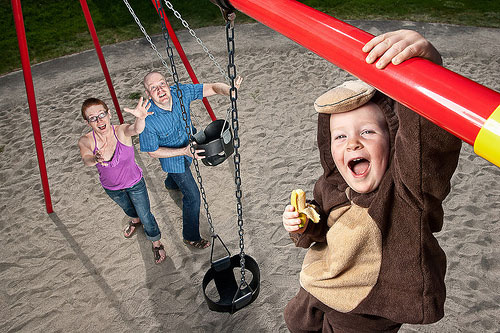
IR: Describe the technical process behind an Extreme Families shoot. What gear to you use and what kind of a set-up as far as lighting, etc. do you typically use?
Van Leeuwen: It's a big technical process, more than most people believe. You rarely see behind-the-scenes on big productions, and most family photo shoots involve a camera and maybe a few flashes, but I pack heavy, and these shoots are all about the light. Without knowing exactly what we might need in a setting, I travel with a portable studio that consists of two Pelican 1560 cases. One case has my Elinchrom Ranger Quadra kit; it has three batteries, two packs, three heads, cables, gels, an eco ring-flash, adapters (to connect the Quadras to Elinchrom Rotolux modifiers) and an 18cm gridded dish. The other case is a speedlight kit with two Canon 600ex-RTs, two Lumopro LP160's, Nano stands, Westcott double-fold umbrellas, a few Justin Clamps, a few umbrella brackets, a bunch of gels, a Pocketwizard miniTT1, Flex TT5s and a few older transceivers. The ones I use most often are the LP160s because I find they work really well with my Quadras as accent lights. I also have an Elinchrom BXRI500 that I carry around in a ThinkTank Photo Urban Disguise 50; this also holds my laptop which is important, since I shoot tethered.
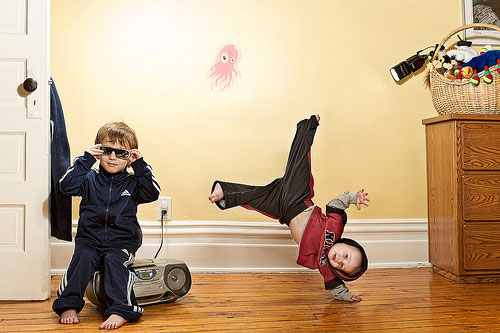
Since all these shoots have been indoors, and I'm trying to work with as low an ISO as possible for a clean image -- but as high an f-stop as I can get away with so that everyone throughout the photo is sharp -- I use the bigger lights to create an artificial "ambient" balance. I'll bounce the big flash off a white wall if possible, or use my larger octa boxes to get the light into the room. I then build some accent light from areas that make sense; visible light sources like windows or light fixtures should give off a light so I'll position something in those areas aimed into the setting to accent it while having it make logical sense. I will then fill in areas that need a bit more pop with the LP160s to finish the look. Sometimes the room is good as-is, and sometimes I need to get my assistant to hand-hold a gridded softbox to add a bit more motivated lighting to help my subjects stand out.
My Elinchrom Light mods include a 135cm Midi Octa, the 100cm Deep Throat Octa, a 40cm Beauty Dish and the maxi-spot reflector. I'm also a big fan of my Photek 64-inch Softlighter umbrella. I use my 24-inch Lastolite Ezybox quite a bit and if that's not big enough my 28-inch Westcott Apollo softbox. It all really just depends on how you need light and where, often it's as simple as bouncing it off a wall.
Shooting tethered helps me make sure everything is sharp, in focus, and it really helps me notice little details I might miss on the back of an LCD. It also allows me to show my clients exactly where we are in the shoot, this way we can switch things up if they're not happy with how it's going, and even make their image selects on the spot. After that it's a good day or so in photoshop and I'm no digital artist. As a photographer I really try and get the stuff right in camera. I can't create something from nothing like some artists, so I try and just get my masking done right which is helped by me shooting carefully on location.
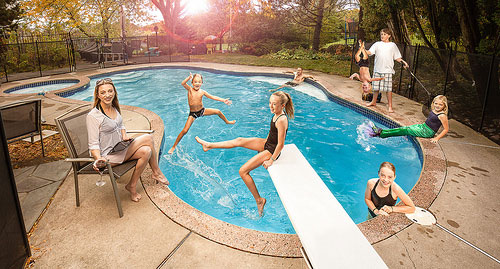
IR: Your Extreme Families shots are "composites." How much work do you do on them in Photoshop and what do you typically do in post-production?
Van Leeuwen: I photograph every member, or sometimes interacting members, of the family individually, so we can focus on that little part of the scene. It takes a bit longer, but it makes everyone happy in the end, since they get to pick their favorite shot of themselves and it all goes into the final product. Photoshop consists of a lot of masking, really, and if I've really tried to challenge myself, stitching the image together. I often expand the scene by creating a panoramic image of the scene, stitching it together, and then masking the people back into the scene as they were shot. I then spend some time dodging and burning, and, then -- as a bit of a final touch -- I like to go into Nik Software's ColorEfex Pro and play around with their filters, just to give the image a bit of a consistent look to bring it together.
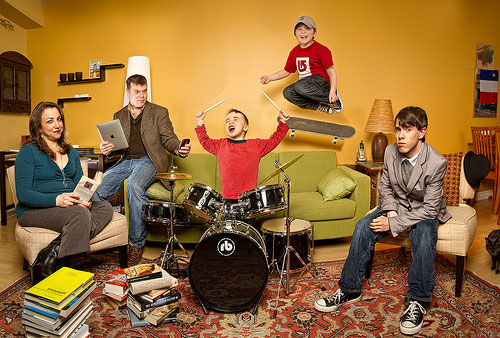
IR: Since this is a somewhat new approach to family portrait sessions, it must be a challenge to sell the concept to potential clients. What has the reaction been and what types of families are attracted to this approach?
Van Leeuwen: I don't go out of my way to sell this to people, as I've learned over the past that it's a love or hate thing. Some people think it's stupid and irresponsible. Those people aren't my clients. The people who want it, love it. They're already sold on the idea since they've seen what I've done with my family, and what other families have done. If you like what I do great: let's work together! If not, no hard feelings. There's absolutely no shortage of people with cameras willing to take your money.
IR: What are you future plans for these Extreme Families photo sessions? Anything you plan to do different?
Van Leeuwen: I honestly want to get better at my compositing, it's nowhere near where I want it to be. And while my clients are happy with what they have (which is the most important part right?), I started doing this to get better, and I just feel it's not good enough yet. I do always try to throw some other wrench into my own work, though, like adding the panoramic element to create larger images, using the compression of a lens but providing a field of view unattainable on a 35mm SLR. I'd like to be able to start incorporating other elements, keeping banks of skies and building and backgrounds and putting them together in a comprehensive way like a lot of great commercial photographers do every day. It's cool to put a family in their kitchen, but it's cooler to put their kitchen in the Amazon, or on Mt. Everest. That would be a fun side project. Bonus: I'd have to travel to those locations to shoot my own stock.
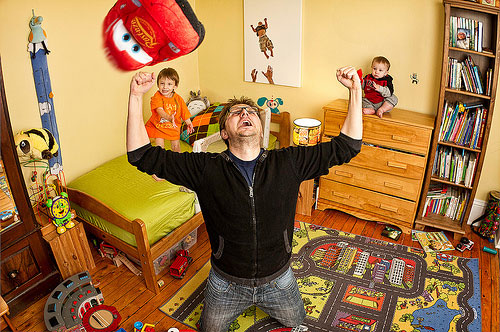
IR: Do you have any other off-the-wall ideas for photography?
Van Leeuwen: I'm definitely not the first guy to do this. And I'm not the last, I'm not the best and I'm hopefully not the worst. That said, sometimes my brain goes to areas that some people find are taboo or inappropriate. I say things aloud that others know better than to even think. I've always been told I "went over a line" but maybe I need need to look closer at what comes to my mind when I'm on the other side of that line and explore potential imagery.
To see more of Van Leeuwen's Extreme Families images, click here.
(Thanks Phil.)